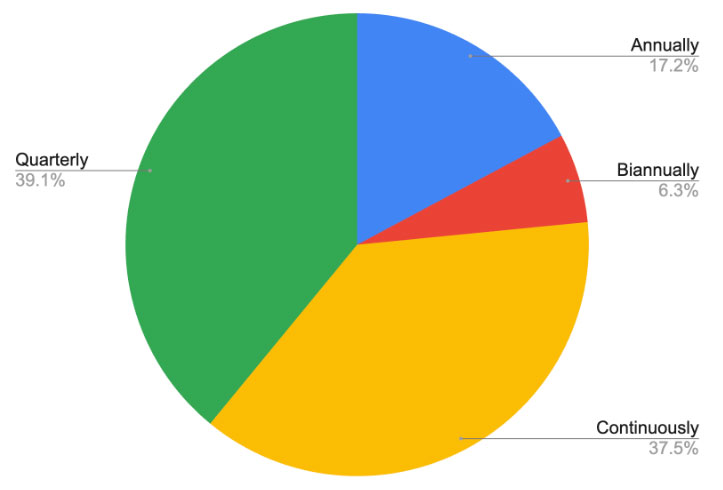Sunday 03 Nov 2024 Article
The Takeaway
V2 - 1 Essential Model and 16 Invaluable Resources for Creating the Perfect Employee Feedback Loop
So, how often do organisations actually collect employee feedback?
To find out, we surveyed our clients and their leaders, managers and HR teams who trust and partner with our organisation, Nine Dots.
64 responded to the question:
“How often does your organisation collect and analyse employee feedback?”
Ultimately, Nine Dots' mission is to support organisations in achieving success. We ask these questions within our network to provide valuable insights into the inner workings of businesses across the UK, helping you make more informed decisions about the best strategies for your organisation.
And Our Survey Said…
The results actually revealed a significant and positive rise in the frequency of how organisations approach employee feedback compared to the more traditional approach.
Not so long ago, annual reviews were the norm, offering a once-a-year snapshot of employee sentiment.
However, our findings indicate that this approach is becoming increasingly outdated as more companies recognise the value of these frequent check-ins.

Continuously: 38% of respondents collect and analyse feedback on an ongoing basis. This shift towards continuous feedback really helps push forward a culture of transparency and responsiveness. As a result of this continuous strategy, these organisations are able to swiftly identify and address issues, ensuring that their teams remain engaged and aligned with company goals.
Quarterly: 39% implement quarterly feedback cycles. This approach strikes a balance between frequent engagement and could be more useful giving their employees time to implement changes and observe the impact of their feedback. Quarterly surveys provide a regular pulse check, allowing companies to address emerging concerns promptly and maintain a dynamic work environment. This is the compulsory/standardised approach we take at Nine Dots.
Annually: Only 17% of companies still rely on purely annual feedback. While this method provides a broad overview of employee sentiment, the fact that 77% of respondents do not choose this method means that companies are starting to realise that an annual approach can often miss the nuances and immediate issues that arise throughout the year. With around 1 in 5 adopting this, it is still a significant strategy for many organisations.
Bi-annually: 6% of companies have moved to a biannual feedback cycle, which we think is a compromise between continuous and annual approaches. With this method, you could have more detailed feedback than an annual approach while mitigating the risk of survey fatigue that you may get with a continuous approach. This strategy can be used to ensure that employees take the time to answer thoroughly rather than sending surveys too frequently, turning into a tick-box exercise.
The Takeaway...
Organisations in our network appear to have embraced more frequent internal feedback strategies. Based on our understanding of our clients, we believe this shift is driven by a desire to cultivate a transparent, engaged, and high-performing workplace.
That said, whether you’re already using frequent feedback or looking to refine your approach, adopting the right process will help ensure that employee voices are heard and that your organisation continues to grow and improve.